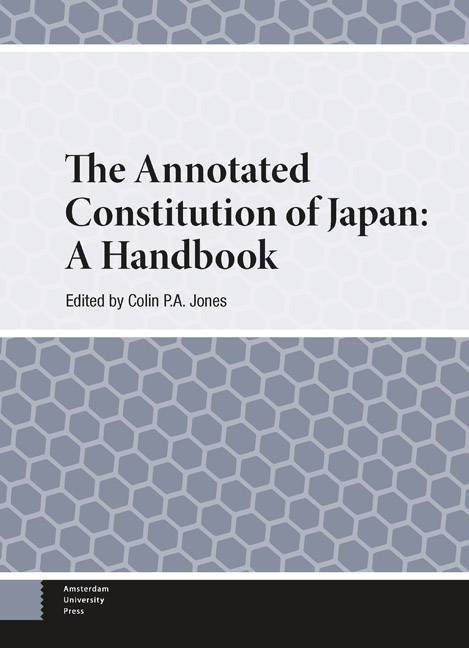Book contents
- Frontmatter
- Dedication
- Contents
- Contributors
- Preface
- Acknowledgements
- Introduction: Historical Overview
- The Preamble
- 1 Chapter I: The Emperor (Articles 1–8)
- 2 Chapter II: Renunciation of War (Article 9)
- 3 Chapter III: Rights and Duties of the People (Articles 10–40)
- 4 Chapter IV: The Diet (Articles 41–64)
- 5 Chapter V: The Cabinet (Articles 65–75)
- 6 Chapter VI: The Judiciary (Articles 76–82)
- 7 Chapter VII: Finance (Articles 83–91)
- 8 Chapter VIII: Local Self Government (Articles 92–95)
- 9 Chapter IX: Amendments (Article 96)
- 10 Chapter X: Supreme Law (Articles 97–99)
- 11 Chapter XI: Supplementary Provisions (Articles 100–103)
- Appendix 1 Constitution of the Empire of Japan (Japanese)
- Appendix 2 Constitution of the Empire of Japan (English translation)
- Appendix 3 The Potsdam Declaration
- Appendix 4 Instrument of Surrender
- Appendix 5 The “MacArthur Notes”
- Appendix 6 The GHQ Draft
- Appendix 7 The Constitution of Japan (Japanese)
- Appendix 8 The Treaty of San Francisco
- Bibliography
- Index
- Index of Articles of the Constitution of Japan
3 - Chapter III: Rights and Duties of the People (Articles 10–40)
Published online by Cambridge University Press: 13 February 2024
- Frontmatter
- Dedication
- Contents
- Contributors
- Preface
- Acknowledgements
- Introduction: Historical Overview
- The Preamble
- 1 Chapter I: The Emperor (Articles 1–8)
- 2 Chapter II: Renunciation of War (Article 9)
- 3 Chapter III: Rights and Duties of the People (Articles 10–40)
- 4 Chapter IV: The Diet (Articles 41–64)
- 5 Chapter V: The Cabinet (Articles 65–75)
- 6 Chapter VI: The Judiciary (Articles 76–82)
- 7 Chapter VII: Finance (Articles 83–91)
- 8 Chapter VIII: Local Self Government (Articles 92–95)
- 9 Chapter IX: Amendments (Article 96)
- 10 Chapter X: Supreme Law (Articles 97–99)
- 11 Chapter XI: Supplementary Provisions (Articles 100–103)
- Appendix 1 Constitution of the Empire of Japan (Japanese)
- Appendix 2 Constitution of the Empire of Japan (English translation)
- Appendix 3 The Potsdam Declaration
- Appendix 4 Instrument of Surrender
- Appendix 5 The “MacArthur Notes”
- Appendix 6 The GHQ Draft
- Appendix 7 The Constitution of Japan (Japanese)
- Appendix 8 The Treaty of San Francisco
- Bibliography
- Index
- Index of Articles of the Constitution of Japan
Summary
Overview
Article 10 of the Potsdam Declaration made the establishment of the respect for fundamental human rights a condition of Japan's surrender. Chapter III of the Constitution of Japan, which covers the rights and duties of the people, was in large part how this principle was put into effect. One major factor which contributed to making the protection of human rights such a focus was undoubtedly the very weak protection they had enjoyed in Japan under the Meiji system, a situation about which we may begin this chapter with a few words.
One well known anecdote related to Japan's selective adoption of a legal system based on western models in the Meiji era is that the language lacked a word that “right” could be translated into and one thus had to be invented from scratch (kenri). The profundity of this story is somewhat blunted by the fact that the Japanese language produces huge numbers of new words each year without it really impacting the ability of people to use the thing being described, and also by the fact that Japan in the preceding Tokugawa era had long experience with concepts analogous to property and contractual rights in the field of private law. It does however usefully serve as a simplified metaphor for the discomfort that members of the Meiji ruling class felt towards the idea of creating a set of legal rights that the people could use specifically against the new state which they were in the process of building.
This unease is reflected in the content of the Meiji Constitution's second chapter which, like Chapter III of the current one, covers rights and duties. The rights enshrined in the Meiji Constitution differed from those in the current constitution in three major ways. The first is that most current rights simply were not in it. Economic and social rights were completely absent while rights related to the criminal process, intellectual freedom and procedural rights against the state for the most part existed only in very rudimentary form. The second is that the small number of rights that were included were always qualified as being subject to the provision of law. While this did not necessarily deprive them of all meaning as they could still serve as a check on arbitrary abuse, it did mean that they could be limited or stripped away through regular legislation as the government saw fit (as it, not coincidentally, often did).
- Type
- Chapter
- Information
- The Annotated Constitution of JapanA Handbook, pp. 47 - 190Publisher: Amsterdam University PressPrint publication year: 2023



